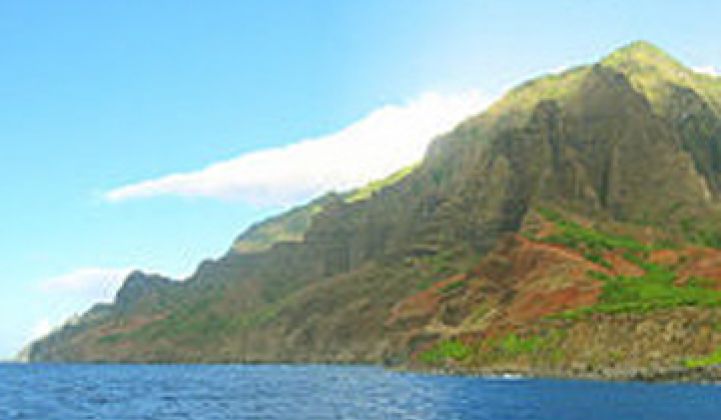Hawaii's state public utilities regulator has approved a request by the Kauai Island Utility Cooperative (KIUC) to release funds for participation in a national smart grid demo project. That means every household on Kauai will be equipped with a smart meter.
It's a low-risk move for Hawaii's Public Utilities Commission, as Kauai is the fourth most-populous island in the state with about 60,000 citizens. It's also mostly rural, which gained it entry into the National Rural Electric Cooperative Association's nationwide demo project.
The Smart Grid Project involves 27 electric cooperatives nationwide, according to KIUC, and is designed to help rural utilities implement smart grid tech. The total cost of the project is about $11.9 million, thanks to Kauai's small grid. KIUC said about half of that cash will come from the American Reinvestment and Recovery Act.
“We are a small island grid and upgrading our electrical grid with smart meters and related technology can make our system more efficient and help integrate new smart appliances, electric cars, and other new and evolving technologies over the coming years,” Mike Yamane, KIUC chief of operations and lead engineer on the project, said in a release.
“New technology can ultimately result in our members saving money if we are able to better control our island's energy demand and be able to defer investing in baseload conventional generation.”
Smart meter installation is projected to start early next year. It will take about two years for KIUC to replace around 33,000 conventional meters as well as install communications infrastructure for grid monitoring and data collection. The actual data gathering and overall analysis of the project will be conducted for three years after the construction phase is finished.
It seems like a small cost to bring improved efficiency and higher-resolution usage data to the state with the nation's highest electricity prices. In a report from July, Greentech Media's Eric Wesoff pointed out some troubling numbers from the island state:
- Hawaii's average electricity rate is about $0.36 per kilowatt-hour, while the nationwide average is about a third of that.
- 75 percent of the state's power comes from oil imported from sources outside the United States.
- The island is 90 percent dependent on fossil fuels, for which the annual bill adds up to 7.5 percent of the state's GDP.
Here's ex-CIA Director Jim Woolsey on oil and Hawaii.
The cost aside, the state's huge reliance on fossil fuels conflicts with its pristine image that helps make the Hawaii a premier world destination. And while the importation of fuel and goods is a necessary part of island life, a single oil spill could have devastating effects on the island's ecology and would likely put a heavy damper on the tourism industry.
With high costs, industry at risk and a whole lot of tropical sun, it seems Hawaii would be the perfect candidate for ambitious solar, geothermal, and renewable projects. In fact, solar has been given a boost this year, with three major projects getting launched over the summer, including the 3.5-megawatt Kikiaola Solar project on Kauai itself.
Hawaii's solar industry has plenty of room to grow, especially when considering that the state's current largest solar farm, in Kapahi, has only a 1.2-megawatt capacity. The push for solar and a smarter grid comes along with a new interest in geothermal production (for which the state has plenty of resources) and electric vehicles, which are nearly a no-compromise proposition on the small islands. Next-generation EV integration challenges will be covered at the upcoming Greentech Media conference The Networked EV: Smart Grids and Electric Vehicles.
The question now is how much prodding it will take for the notoriously slow-moving state utility, the Hawaiian Electric Company, to begin to let go of its institutional love affair with fuel oil.



